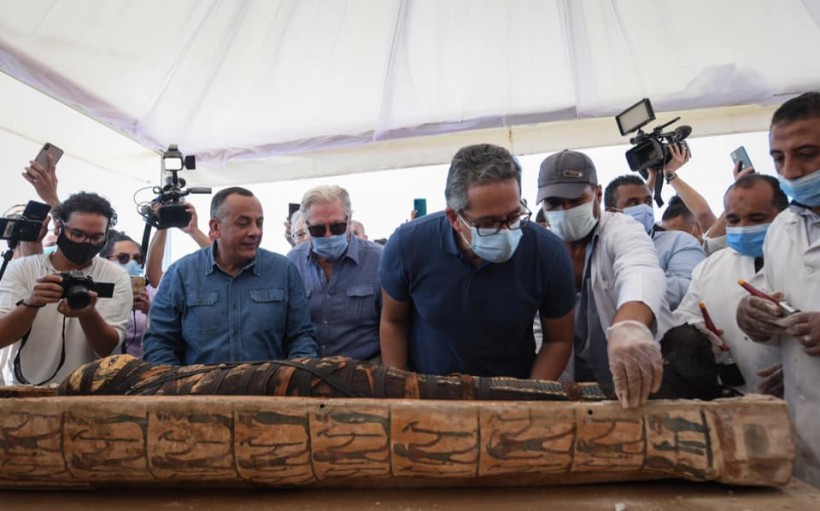Almost five dozens of ancient coffins were found in a necropolis, or "city of the dead," near Saqqara, south of Cairo in Egypt.
According to Khalid el-Anany, tourism and antiquities minister of Egypt, there are at least 59 sealed sarcophagi recovered in three separate wells. Most of them contained mummies inside them, dated more than 2,600 years ago.
"I consider this is the beginning of a big discovery," el-Anany said in a statement, adding that there remains a currently unknown number of sarcophagi in the area that remains undiscovered.

Dr. Khalid el-Anany (center, foreground), tourism and antiquities minister, examines one of the uncovered stone coffins from a recent archaeological find at Saqqara, south of Cairo in Egypt.
From the Saqqara Necropolis
The Egyptian tourism and antiquities minister made the announcement at a press conference at The Step Pyramid of Djoser - a 62-meter (203 feet) archaeological wonder - which was also the site of the discovery. The Step Pyramid is located as a part of the larger Saqqara necropolis. As a part of the conference in honor of the find, one of the sarcophagi was opened in full view of the media, as well as attending diplomats.
Located south of Cairo, the Saqqara plateau is a large burial ground that served as the necropolis for the Egyptian capital of Memphis. It is home to at least eleven pyramids, the oldest complete of which was the Pyramid of Djoser built around 2670 to 2650 BC, in the Egyptian Third Dynasty (c. 2686 - 2613 BC). However, there were older structures in the area, including those from the First Dynasty (c. 2920 - 2770 BC) up to the Ptolemaic and Roman periods.
RELATED: 8 Mummies, 1,000 Statues, 10 Sarcophagi Discovered At 3,500-Year-Old Tomb In Luxor, Egypt
North of Saqqara is Abusir and south of it lies Dahshur - two other necropolis with the latter being a famed burial site for members of royalty. Both areas also contain their respective pyramids, with The Great Pyramid of Giza being a part of the large burial complex
The plateau was designated as a UNESCO World Heritage Site in 1979.
Today from Saqqara.. The announcement of the new archeaological discovery Egypt is attracting the world
اليوم من سقارة والأعلان عن الاكتشاف الآثري الجديدمصر تجذب العالم #egyptiancivilization #newdiscovery #Egypt #Saqqara #egyptianheritage #egyptianarchaeologists pic.twitter.com/RSooy8PWBc — Dr Mostafa waziry (@mostafa_waziri) October 3, 2020
The Latest in a Series of Egypt's Archaeological Renaissance
According to Mostafa Waziri, Supreme Council of Antiquities Secretary-General, initial studies from the recovered sarcophagi revealed that these contained priests, government officials, and royals from the Pharaonic Late Period (c. 664 - 525 BC).
Additionally, Waziri noted the discovery of about 28 statuettes of Ptah-Soker, the main god associated with the Saqqara necropolis, as well as a 35 cm tall bronze statuette of the god Nefertum - inlaid with valuable stones like red agate, turquoise, and lapis lazuli. The name of its owner, Badi Amunis, was found engraved on the base of the Nefertum statuette. Badi-Amun was a priest from the 26th Dynasty.
RELATED: 27 Stone Tombs Discovered in One of Egypt's Prominent Necropoli
The latest announcement follows the discovery of 27 ancient coffins, found in a newly-excavated 11 meter deep (36 feet) well last month. El-Anany added that the Saqqara discoveries will join 30 other sarcophagi discovered last October in Luxor, in Upper (southern) Egypt. Together, these archaeological finds will be displayed at the opening of the new Grand Egyptian Museum (GEM), currently under development at Giza, near the famed pyramids. The GEM is also set to showcase the complete Tutankhamun collection, as well as a large archive of discoveries never before displayed in any other location.
Check out more news and information on Egyptian Mummies in Science Times.













!['Cosmic Glitch' in Einstein's Theory of General Relativity Could Be Explained in This New Scientific Tweak [Study]](https://1721181113.rsc.cdn77.org/data/thumbs/full/53435/258/146/50/40/cosmic-glitch-in-einsteins-theory-of-general-relativity-could-be-explained-in-this-new-scientific-tweak-study.jpeg)
